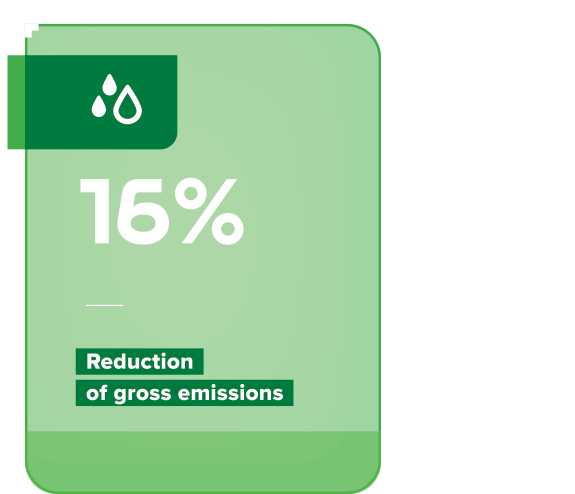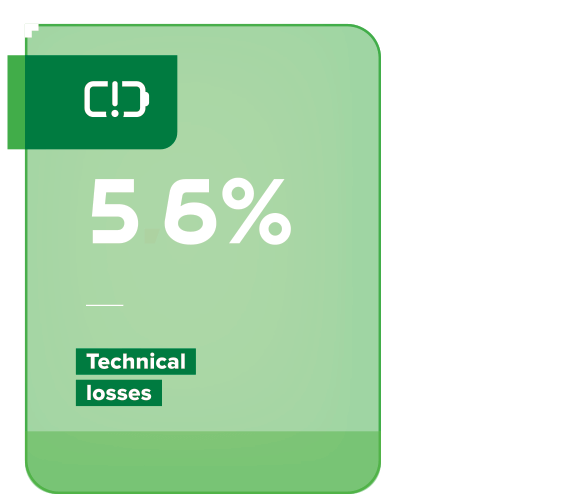Environmental
Protection
Environmental responsibility is a key principle of KEGOC Environmental Policy
Environmental
Policy
KEGOC considers environmental activities as an integral part of its day-to-day operations. Environmental responsibility is a key principle of KEGOC Environmental Policy.
The goals of KEGOC Environmental Policy are to minimize adverse environmental impact, increase the level of environmental safety, take responsibility for environmental security of Kazakhstan NPG development, promote energy saving and rational use of environmental and energy resources in the Company’s activities. KEGOC’s management takes the responsibility for implementation of obligations taken in accordance with Environmental Policy on continuous improvement and pollution prevention, as well as obligation to meet applicable legislative and other requirements related to KEGOC in terms of its environmental aspects. All employees of the Company as well as employees of contractors working for the Company’s interests shall review KEGOC’s Environmental Policy.
The Company implemented the environmental management system, which is certified for compliance with the requirements of international standard ISO 14001. The system operates as part of KEGOC’s integrated management system. The main objective of its implementation and operation is to apply new management methods that would enhance the influence on the environmental aspects of the Company’s operational and economic activities. The environmental aspects management is a component of the corporate risk management system in KEGOC.
For efficient management, KEGOC developed registers of environmental aspects for 2021. When identifying the aspects, all components of the environmental impact of the Company’s activities are analysed (energy saving, water, soil, emissions, waste). Activities to manage environmental aspects are specified in the Company’s Environmental Programme for 2021. “Potential Polychlorinated Biphenyls polychlorinated biphenyl (PCB) containing waste”, “transformer oil” and “waste transformer oil” were identified as critical environmental aspects in 2021. The “potential PCB-containing waste” aspect is critical due to the fact that the polychlorinated biphenyl is a dangerous substance according to the Environmental Code of the Republic of Kazakhstan (red hazard level). The “spent transformer oil” and “transformer oil” aspects are critical due to the existence of oil-filled equipment.
Ambient
Air Protection
According to the standards, the MES branches identified stationary sources of harmful emissions (both organized and unorganized emission sources). In order to monitor emissions from stationary sources, the MES branches conducted in 2021 the operational monitoring (monitoring of the operating process), namely, kept records of hours of operation for each item of equipment and consumption of materials. The environmental monitoring of operations conducted by the qualified organisations determine stationary resource emissions through calculations or laboratory measurements.
In 2021, the volume of gross emissions of contaminants from stationary sources amounted to 9.79 tonnes (the established standard being 11.63 tonnes).
Emissions from stationary sources in 2021
| Name of KEGOC’s MES branch | Emissions from stationary sources, t/y | |
| Standard | Actual | |
| Akmolinskiye MES | 0.93 | 0.52 |
| Aktyubinskiye MES | 0.31 | 0.07 |
| Almatinskiye MES | 0.73 | 0.73 |
| Vostochnye MES | 1.42 | 2.38 |
| Zapadnye MES | 0.84 | 0.01 |
| Sarbaiskiye MES | 0.68 | 0.68 |
| Severnye MES | 1.23 | 0.15 |
| Tsentralnye MES | 5.18 | 5.18 |
| Yuzhnye MES | 0.30 | 0.09 |
| Total | 11.63 | 9.79 |
Thus, gross emissions from stationary sources (with regard to standard rate) dropped by 16%. The fact of the reduced emissions (Akmolinskiye MES, Aktyubinskiye MES, Almatinskiye MES, Zapadnye MES, Severnye MES and Yuzhnye MES branches) was supported by the findings of the environmental monitoring that was conducted by the specialized organisations.
According to the UN Framework Convention on Climate Change, Kyoto Protocol, Paris Agreement and environmental laws of the Republic of Kazakhstan, the MES branches made an inventory of greenhouse gases emitted as a result of the Company operations in 2020. Greenhouse gas emissions from stationary sources, and mobile sources equated to stationary sources were calculated. The 2020 reports on inventory of greenhouse gases were registered and sent to the territorial environment departments.
In accordance with the Resolution of the Government of the Republic of Kazakhstan “On approval of the list of greenhouse gases subject to state regulation”, the list includes carbon dioxide (CO2), methane (CH4), nitrous oxide (N2O) and perfluorocarbons (PCFs). Following the results of inventory of greenhouse gases emitted by stationary sources, emissions amount to 138.02 tonne carbon dioxide equivalents a year (16.45 tonne less than in 2020), in this connection KEGOC does not fall within the requirements for greenhouse gas cap-and-trade according to the National Plan for Greenhouse Gas Quota Allocation for 2018–2020.
Greenhouse gas emissions from stationary sources of KEGOC in 2021, tonnes
| СО2 | СН4, tonne carbon dioxide equivalent | N2O, tonne carbon dioxide equivalent | Total emissions in the tonne carbon dioxide equivalent |
| 137.97 | 0.0016 | 0.04638 | 138.02 |
The intensity of greenhouse gas emissions from stationary sources in 2021 was 0.0025 tonnes per 1 million kWh of electricity transmitted.
According to the Code of the Republic of Kazakhstan on taxes and other mandatory payments to the budget the emissions from mobile sources are not measured, the reports specify the amount of the used fuel. The vehicles were tested for toxicity and opacity of exhaust gas.
In 2021, the Company started to develop Carbon Footprint Reduction Programme until 2060. The reduction of KEGOC’s own carbon footprint is subject to analysis and elaboration of further activities of the Programme. The issues of ensuring decarbonization of the economy through the development, integration of RES into the energy system of Kazakhstan are the strategic goals and objectives of the main activities of KEGOC as the System Operator and reflected in KEGOC’s Development Strategy for 2022-2031.
During the Programme development the current situation is analysed and the main sources and indicators of direct and indirect СО2 emissions (Scope 1 and 2) are identified, the main measures to reduce the carbon footprint of the Company in its operations are determined and the key indicators for monitoring of KEGOC carbon footprint reduction are identified.
The main tools in the implementation of KEGOC’s climate ambitions are the measures in the short and medium term:
- organisation of information collection and monitoring process and possible reduction of fuel and energy resources consumed;
- energy saving and energy efficiency improvement;
- gradual increase of the share of green power purchase from RES for compensation of losses in KEGOC network.
Thus, the Programme specifies the indicators for achieving low-carbon development until 2031:
- for Scope 1 (direct emissions) – through gradual replacement of passenger cars with internal combustion engines with similar vehicles with electric motors to achieve 2% emission reduction by 2030;
- for Scope 2 (indirect emissions) – through gradual increase of the share of purchased green electricity from RES to compensate losses in KEGOC grid to reach 20% by 2031.
The Company does not emit any ozone-depleting substances influencing the climate change.
Waste
Management
The waste products are generated in the course of operation, repair and rehabilitation of the SS equipment. Waste management in KEGOC is guided by the Environmental Code of the Republic of Kazakhstan and corporate standard “Waste management in KEGOC”.
At KEGOC, all wastes are divided into dangerous and non-dangerous.
Waste Volume in KEGOC Divisions
| Indicator, tonnes | 2021 |
| Dangerous waste | 1,782.82 |
| Non-dangerous waste | 2,543.26 |
| Total | 4,326.09 |
Water
Impact
The Company does not use water in its operational process. Water consumption by the Company is insignificant, so this has no material influence on used water sources. Water is consumed and discharged in accordance with contracts concluded by MES branches with specialized organisations. There are no discharges into water facilities and relief. Water is supplied from artesian wells at seven KEGOC branches; the wells are used according to obtained permissions. The specialised organisations are contracted to permanently monitor the ground water intake facilities in accordance with the Water Code of Kazakhstan.
Environmental Actions
during Investment Projects
Implementation
The Company addresses the environmental issues in a comprehensive way when implementing projects, including investment projects. PESTEL analysis is used to analyse the risks of project implementation, including analysis of social and environmental risks. The results of the conducted environmental impact assessment are taken into account, and the option that does the least harm to the environment and human health is adopted. Identification and assessment of project risks are carried out on a regular basis and at all stages of project implementation. The impact on atmospheric air, surface and groundwater, landscapes, land resources and soil cover, biodiversity and more is estimated.
In order to manage the environmental risks, the design provides that the grid facilities must be arranged in the territories well removed from populated areas and designated conservation areas. OHTL routes mainly pass along steppes and semideserts. Should the OHTL cross the forest-steppe zone, the environmental impact assessment (EIA) is prepared to clean glades for the OHTL and take mitigation measures. For the purpose of transparency and availability of the environmental information on the Company’s activities, the public hearings of draft EIAs are held.
Energy Efficiency
The main objectives of energy saving and efficiency improvement at KEGOC is to reduce the consumption of fuel and power resources through reduction of auxiliary energy consumption by KEGOC facilities, reduction of process electricity loss while transmitting via the national power grid, improvement of the methods used for monitoring of energy consumption, and provision of the Company’s facilities with electricity meters and other devices for metering of fuel and power resources, organisation of the information acquisition processes based on the metering devices.
Consumption of Fuel and Energy Resources in 2021, GJ*
| Electricity | 10,951,741.26 |
| Heat power | 87,536.44 |
| Fuel | 123,520.85 |
| в том числе: | |
|
41,680.78 |
|
77,940.90 |
|
3,749.09 |
|
150.07 |
| Total | 11,162,798.55 |
Consumption of fuel and energy resources increased by 812,281.78 GJ in 2021 compared to 2020 caused by delivered electricity increase, which resulted in electricity loss volumes increase.
In 2021, specific energy consumption made 0.2 GJ per 1 thousand kWh of electricity transmitted.
The most effective, in terms of reducing the energy consumption, are the measures on reduction of technological consumption of electricity in transmission lines.
The electrical power system of Kazakhstan is defined by large concentration of powerful energy sources in the North and long length transit lines (about 1,000 km) (main transits include Kazakhstan North – South transit and Pavlodar oblast – Aktobe oblast transit): this is due to the vast territory of Kazakhstan and materially affects the level of technical losses. The technical losses in KEGOC grid depend on the operation modes of neighbouring states’ power systems (electricity transit, export and import) and climatic conditions.
* – When converted to Joul, the international system of units (SI) was used.
KEGOC’s electricity losses structure for 2021

The technical losses in KEGOC networks in 2021 amounted to 3.012 billion kWh or 5.6w% of electricity supply to the grid based on the metering devices.
It should be understood that technical loss of electricity means the loss of electric power resulting from the physical processes in conductors and electrical equipment which occur during the electricity transmission across transmission lines. Thus, the main goal of planning and introducing the measures on reduction of electric power losses is to bring the actual amounts of technological loss to its optimal level.
Due to the measures on electricity loss reduction implemented, in 2021 the decrease in electricity consumption amounted to 4.392 million kWh.
| Activity | Outcomes | |
| million kWh | GJ | |
| Line tripping under low-load conditions | 0.478 | 1,721 |
| Shutdown of power transformers under low load conditions | 3.914 | 14,089 |
| Total for KEGOC | 4.392 | 15,810 |



